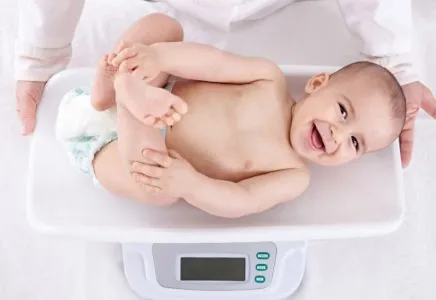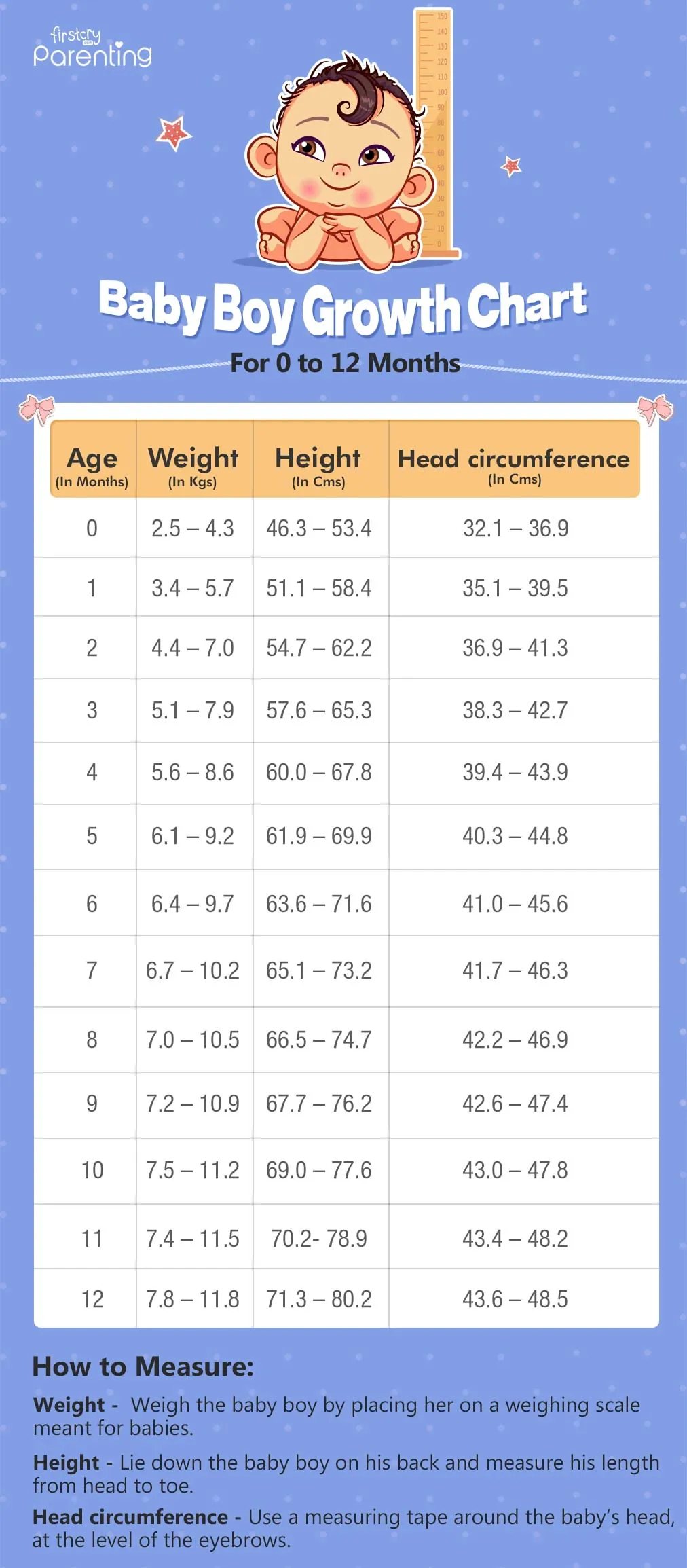Baby Boy Growth Chart – Height & Weight

- Baby Boy Growth Chart
- Tips to Read the Growth Chart
- How to Measure Your Baby Boy’s Growth at Home?
- Why Is It Important to Have a Baby Boy Growth Chart?
- What Factors Influence Your Baby’s Growth?
- Does Birth Weight Affect a Baby’s Growth?
- When Should You Consult a Doctor?
- FAQs
- Infographics: Baby Boy Growth Chart For 0-12 months
A growth chart is an essential tool used to assess whether your baby is developing according to typical standards. It’s important to note that boys and girls grow at different rates, with boys generally being slightly heavier and taller than girls on average. This difference underscores the necessity of using a specialized baby boy percentile growth chart. By utilizing this specific boys growth chart, you can more accurately monitor and track your baby boy’s growth over time, ensuring he is growing healthily and meeting the expected developmental milestones for his age and gender. This can provide reassurance or prompt early interventions if needed.
Baby Boy Growth Chart

Here’s the baby boy growth chart as given by the World Health Organization (1). The growth chart for boys gives the height, weight and head circumference readings from the 3rd to the 97th percentile. To track your baby’s growth, plot his measurements over a graph and compare them with this growth chart for baby boys.
| Age in Months | Height (cm) – 3rd to 97th percentile | Weight (Kg) – 3rd to 97th percentile | Head circumference (cm) – 3rd to 97th percentile |
| 0 | 46.3 – 53.4 | 2.5 – 4.3 | 32.1 – 36.9 |
| 1 | 51.1 – 58.4 | 3.4 – 5.7 | 35.1 – 39.5 |
| 2 | 54.7 – 62.2 | 4.4 – 7.0 | 36.9 – 41.3 |
| 3 | 57.6 – 65.3 | 5.1 – 7.9 | 38.3 – 42.7 |
| 4 | 60.0 – 67.8 | 5.6 – 8.6 | 39.4 – 43.9 |
| 5 | 61.9 – 69.9 | 6.1 – 9.2 | 40.3 – 44.8 |
| 6 | 63.6 – 71.6 | 6.4 – 9.7 | 41.0 – 45.6 |
| 7 | 65.1 – 73.2 | 6.7 – 10.2 | 41.7 – 46.3 |
| 8 | 66.5 – 74.7 | 7.0 – 10.5 | 42.2 – 46.9 |
| 9 | 67.7 – 76.2 | 7.2 – 10.9 | 42.6 – 47.4 |
| 10 | 69.0 – 77.6 | 7.5 – 11.2 | 43.0 – 47.8 |
| 11 | 70.2- 78.9 | 7.4 – 11.5 | 43.4 – 48.2 |
| 12 | 71.3 – 80.2 | 7.8 – 11.8 | 43.6 – 48.5 |
Tips to Read the Growth Chart
Understanding the height and weight chart is simple. If you’re referring to a baby boy weight chart by month, you would see that the vertical axis on the left of the chart gives the months of the baby. The horizontal axis has the baby’s weight marked on it. For example, if your baby is in the 25th percentile, it means that 24% of baby boys of the same age weigh less than your child and 75% weigh more. A baby boy height and head circumference chart are similar to the weight growth chart boy.
Keep in mind that the percentile for height and weight need not always be the same. For example, your baby may be 40th percentile in weight but in the 60th percentile in height and this can vary as they grow older.
How to Measure Your Baby Boy’s Growth at Home?
You can easily measure your baby at home. Here’s how:
- Height: Measuring your baby’s height may be a bit difficult as he might wriggle a lot. Place him on a flat surface like a bed or table and stretch his legs out. Using a tape measure, note his height from the top of his head to the soles of his feet.
- Weight: You can get a baby weighing scale to measure your boy’s weight.
- Head Circumference: Wrap a tape measure around the widest part of your baby’s head. It should pass above the eyebrows and ears.
Why Is It Important to Have a Baby Boy Growth Chart?
A growth chart helps both you and your paediatrician assess your child’s nutrition status, height and weight. Proper development is crucial in the first six years of a baby’s life, so it’s important to track your boy’s growth with the help of this boys growth chart for height and weight.
What Factors Influence Your Baby’s Growth?
Your baby boy’s growth depends on multiple factors such as:
1. Feeding
All the nutrition that your baby needs comes from feeding and it significantly determines his growth. Until six months, he’s dependent on breast milk or formula for his nourishment. Adequate feeding also supports other factors that influence growth.
2. Mother’s Health During Pregnancy
Your diet, weight, and lifestyle have a major influence on how your baby develops in the womb. That, in turn, affects the nutrients stored in your baby’s body and influences his growth in the first year.
3. Baby’s Birth Weight
The birth weight is an indicator of how well your baby was nourished during pregnancy.
4. Genes
Genes play a major role in a baby’s development. Babies whose parents are tall and well-built tend to be in a higher percentile of height and weight. On the other hand, babies of moderately-built parents tend to be lean.
5. Minor Ailments
Flu and ear infections can temporarily affect your baby’s growth. He may not feed well when he’s sick. But he should return to normal once he starts recovering.
6. Mother’s Health After Pregnancy
If you’ve been unwell or suffer from conditions such as postnatal depression, it affects the way you take care of your baby. This has an influence on his growth rate. However, it will improve once you recover from the ailment.
Does Birth Weight Affect a Baby’s Growth?
Not really. Birth weight plays an insignificant role in a baby’s growth and development. Rather, genes from the parents determine this. After birth, the growth rate becomes more dependent on the infant’s genetic background. An important phenomenon often called catch-up or catch-down growth occurs in the first 18 months of life. In two-thirds of children, the growth rate percentile shifts linearly until the child reaches his or her genetically determined growth channel or height percentile. Some petite babies grow into tall and muscular men while some chubby babies become lean as they grow up.
When Should You Consult a Doctor?
Some children who grow significantly later in life. It’s the opposite for kids who grow rapidly at a young age. To know if your baby is growing well, plot his height and weight regularly and compare with a growth chart. However, if you see that your boy is at either end of the infant boy growth chart for a long time, it’s best to consult a paediatrician.
FAQs
1. How often should my baby boy be measured?
It’s recommended that your baby boy be measured during regular pediatric visits. Typically, measurements are taken at birth, within the first week of life, and at 1, 2, 4, 6, 9, and 12 months. These frequent checks help to promptly identify any deviations from normal growth patterns.
2. What should I do if my baby’s growth is below the 5th percentile or above the 95th percentile?
If your baby’s growth is consistently below the 5th percentile or above the 95th percentile, it’s important to consult with your pediatrician. Extreme percentiles can sometimes indicate underlying health issues, but they can also be normal variations in growth. A healthcare provider can evaluate whether your baby’s growth pattern is healthy or if further investigation and intervention are needed.
3. How do genetics influence my baby boy’s growth?
Genetics play a significant role in determining a baby’s growth trajectory. The height and weight of the biological parents often provide clues about how a child might grow. However, environmental factors like nutrition and overall health also significantly influence growth.
4. Can a baby boy’s growth chart predict his future height?
While a baby boy’s growth chart can give some indication of his future height, it is not a definitive predictor. Many factors, including genetics, nutrition, and overall health, will influence his ultimate adult height. The growth trend in the first year can offer a rough estimate, but changes in growth patterns can occur as the child ages.
In short, a baby boy’s growth chart from 0 to 12 months like the one given above helps parents track their baby’s growth and development. While every child is different and each baby grows at their own pace, the chart provides typical ranges for weight, height, and head size. Regular visits to the paediatrician and feeding the child a balanced diet are important to support healthy growth. By understanding the expected milestones, parents can focus on giving their baby the best start in life.
Infographics: Baby Boy Growth Chart For 0-12 months
References/Resources:
1. Length-for-age BOYS; World Health Organization; https://cdn.who.int/media/docs/default-source/child-growth/child-growth-standards/indicators/length-height-for-age/cht-lfa-boys-p-0-2.pdf
2. Growth Problems in Children; University of Rochester Medical Center Rochester; https://www.urmc.rochester.edu/encyclopedia/content.aspx?contenttypeid=90&contentid=p01956
3. Predicting a Child’s Adult Height; American Academy of Pediatrics; https://www.healthychildren.org/English/health-issues/conditions/Glands-Growth-Disorders/Pages/Predicting-a-Childs-Adult-Height.aspx
4. Your Newborn’s Growth; Nemours Kids Health; https://kidshealth.org/en/parents/grownewborn.html
5. Understanding baby growth charts; Pregnancy Birth & Baby; https://www.pregnancybirthbaby.org.au/understanding-baby-growth-charts
6. Khadilkar. V, Khadilkar. A; Growth charts: A diagnostic tool (Indian Journal of Endocrinology and Metabolism); National Library of Medicine; https://www.ncbi.nlm.nih.gov/pmc/articles/PMC3183514/; September 2011
7. Warrier. V, Krishan. K, Shedge. R, Kanchan. T; Height Assessment; National Library of Medicine; https://www.ncbi.nlm.nih.gov/books/NBK551524/
Infant Milestone Chart
Baby Head Circumference Chart
Baby Girl Weight and Height Chart
Was This Article Helpful?
Parenting is a huge responsibility, for you as a caregiver, but also for us as a parenting content platform. We understand that and take our responsibility of creating credible content seriously. FirstCry Parenting articles are written and published only after extensive research using factually sound references to deliver quality content that is accurate, validated by experts, and completely reliable. To understand how we go about creating content that is credible, read our editorial policy here.

























